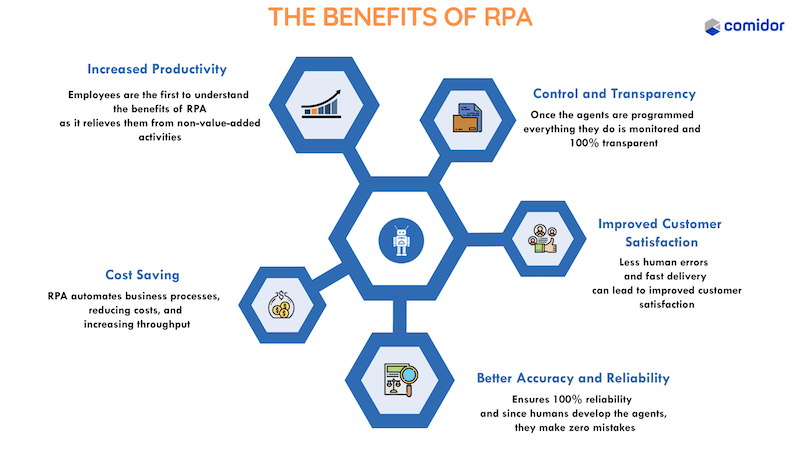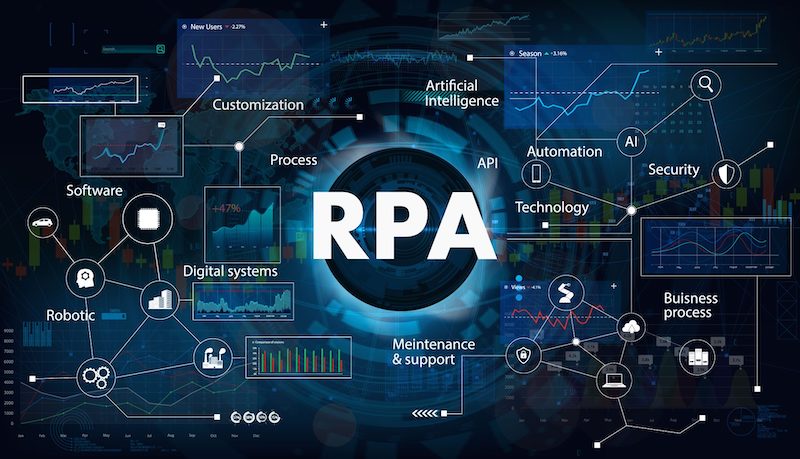Five RPA Benefits for Business Digitalization
Digital transformation and RPA
Digital transformation has become synonymous with development and success. Digitalization helps companies to serve their customers better, work more efficiently and gain a prerogative over competitors. To update the format of work, one needs the right technology. One of them is robotic process automation (RPA). Let’s consider the RPA benefits for digital business transformation.
RPA: when robots take over our tasks
Robotic process automation is a technology based on software robots, chatbots, AI, or ML. It automates repetitive tasks that are usually performed manually.
The program imitates human behavior and performs routine operations instead of a person or together with a human. Recently, a new trend has emerged – to train RPA and make it smarter with the help of AI and ML algorithms.

One of the main advantages of RPA is that such software works more accurately and faster than a human, performing all the necessary calculations more efficiently.
The technology works with Enterprise Resource Planning (ERP), third-party web services, and outdated software. Therefore, there is no need to redesign the corporate program to implement an RPA system.
With the implementation of RPA, a team has time for more valuable tasks: customer service, increasing sales, and adjusting the marketing strategy. RPA also provides analytics about the operation and performance of an organization.
Based on the extracted data, the management adopts a digital strategy for the development of the company, and robots speed up and simplify its implementation.
How RPA is changing digital business
According to Gartner, digital transformation (DT) is the application of information technology to build a new business model. The management implements IT solutions to improve operations and communication with customers and increase sales.
Automation streamlines the work of companies and supports digital transformation in insurance, finance, logistics, medicine, and other industries. PWC found that businesses can automate 45 percent of tasks and save $2 trillion. UiPath calculated that RPA reduces costs by up to 80%. Organizations see investments pay off in less than a year.
RPA systems encourage businesses to rethink how they work and improve operations. For example, when the personal data of an employee changes, this information must be entered into all documents related to the specialist.
A bot will edit information in payroll systems, benefits, and other programs. The program simulates the keystrokes and mouse clicks that a human would make. The bot learns from an HR manager to update records in payroll systems.
Companies use RPA in different ways in business digitalization processes:
- Financial institutions benefit from automatic billing, verification, and collection of data from multiple files, processing of tax records, and more.
- With the help of robots, it is easier for logistics companies to control inventory, analyze information, check purchase orders, send invoices, and complete other assignments.
- Robotics helps medical centers to manage claims, schedule patient visits, enter information into their ERP systems, and so on.
- RPA in industry handles bills of materials, tracks inventory, issues delivery confirmation documents, and performs other tasks instead of humans.
In any company, there are basic repetitive tasks that can be automated. Therefore, the cost of robotic process automation software is growing. In 2020, enterprises spent $1.3 billion on innovation (Gartner). According to Forrester, in 2021, this figure grew to $2.9.
However, automation is no substitute for digital business transformation. This is a small albeit significant part of modernization. Organizations are applying the benefits of RPA to separate solutions. Digitalization is embracing more important challenges of an enterprise.

RPA as an engine of digitalization
Robotic process automation is of use for digital transformation.
1. Robotization accelerates DT.
Digitalization implies that the company creates robotic process automatization software that will improve the business model. It can also update the old system, which is also laborious.
In any corporation, there is at least one outdated program that is risky to touch. It holds the critical functions of the company and replacing it with a modern version will cost up to hundreds of thousands of dollars.
The RPA allows you to enhance and automate old systems without risk to the company. It would take an RPA software company 2-6 weeks to launch a robot for a single task. As long as the technology is functioning, it is possible to update the old software or create new solutions.
2. It guarantees the quality of digital business transformation.
One of the top priorities of DT is to improve employee efficiency and productivity. Machines rule out human errors. Tasks are completed quickly and efficiently. A person would need 4 hours to create a monthly report. RPA allows doing it in 25 minutes. A specialist will profit from the time saved and perform more tasks than before.
3. It provides an enhanced digital experience.
A significant component of digital transformation is high-quality customer service. People don’t like to wait for a long time for an insurance company to process a claim or a bank to approve a loan application.
They want to quickly resolve issues and forget about them. Automation provides a perfect digital experience. The same chatbot can communicate with customers 24/7 and respond to multiple buyers at the same time.
4. It collects analytics to implement the modernization strategy.
Software bots work with corporate data. The information collected by RPA can be examined to identify patterns. For example, which procedures are performed more often and when exactly. This kind of information will be useful to continually improve operations and drive your digital transformation strategy forward.
5. It opens up new opportunities for team members.
Employees who are burdened with routine tasks are more likely to change jobs. The Forrester study The Impact of RPA on Employee Experience found that employee engagement increases when specialists are freed from repetitive tasks. Employees can participate in more complex and beneficial business cases.
Robotic process automation software can automatically collect, upload, or synchronize call center customer information. The operator no longer needs to do this manually while simultaneously communicating with the caller. Instead, they will focus on an emotional connection with the client.
Four steps to implement robotization in your business
The first step towards robotization is to make sure that the automation goals are in line with the DT strategy. When the global goal of digitalization is to improve the quality of the customer experience, RPA must influence this indicator.
It is also worth doing the following:
1. Consider long-term planning.
Forbes estimates that up to 50 percent of RPA deployments fail initially. One of the reasons for that is the high expectations of management. Automation is not as easy to scale as it seems. Transition to machines needs to be carefully planned and well managed.
One needs to maintain a large fleet of software bots. It is worth understanding whether robots will “take root” as digitalization spreads in the company. Will they interfere with future scaling?
2. Clearly define robotization success metrics.
To evaluate how successful the implementation of the RPA system has been, it is useful to establish success metrics in advance. These indicators are:
- the average time to perform an operation by a bot compared to a human;
- frequency and recurrence of the RPA use;
- expected business value and cost savings;
- reduced costs for operational errors and other metrics.
It makes more sense to identify measurable benefits at the very beginning of the program so that investments in robotic automation can pay off.
3. Engage an RPA software company.
Updating the ERP, financial system, or website that the bot is “visiting” can disrupt an automated task. The program will collect and process incorrect information. You should cooperate with IT professionals who will not only create robotic process automation software but also be able to support it in the long term.
4. Prepare employees for future innovations.
For robotization to go smoothly, the staff must be ready for changes. They must understand that certain tasks will be delegated to the robot. Companies need to change their mindset and culture so that team members perceive RPA not as a competitor but as an assistant.
Maximum benefit
RPA is an ideal first step towards the digitalization of companies and the development of tomorrow’s business models. But thoughtless automation without planning and success metrics will fail.
For maximum benefit, it is worth identifying the tasks for automation, assessing the potential profitability of the system, and choosing a reliable RPA software company.
Experienced IT specialists will offer a comprehensive solution to problems, help to implement the software in the company’s workflow, and provide support.
About the author: My name is Alexandr Khomich, and I data with a diverse set of interests across machine learning, finance, and technology. Currently, I work as a CEO at Andersen. Being a part of the IT family for years, I aim at transforming IT processes in support of business transformation.
Author’s Linkedin: https://www.linkedin.com/in/a-khomich
Author’s email: a.khomich@andersenlab.com

